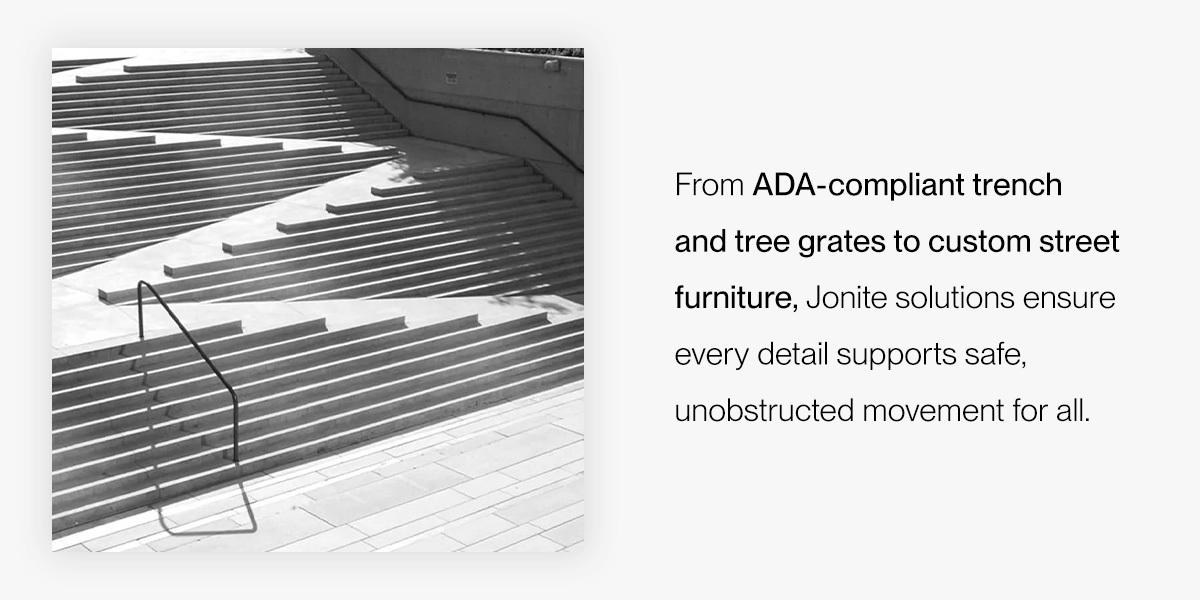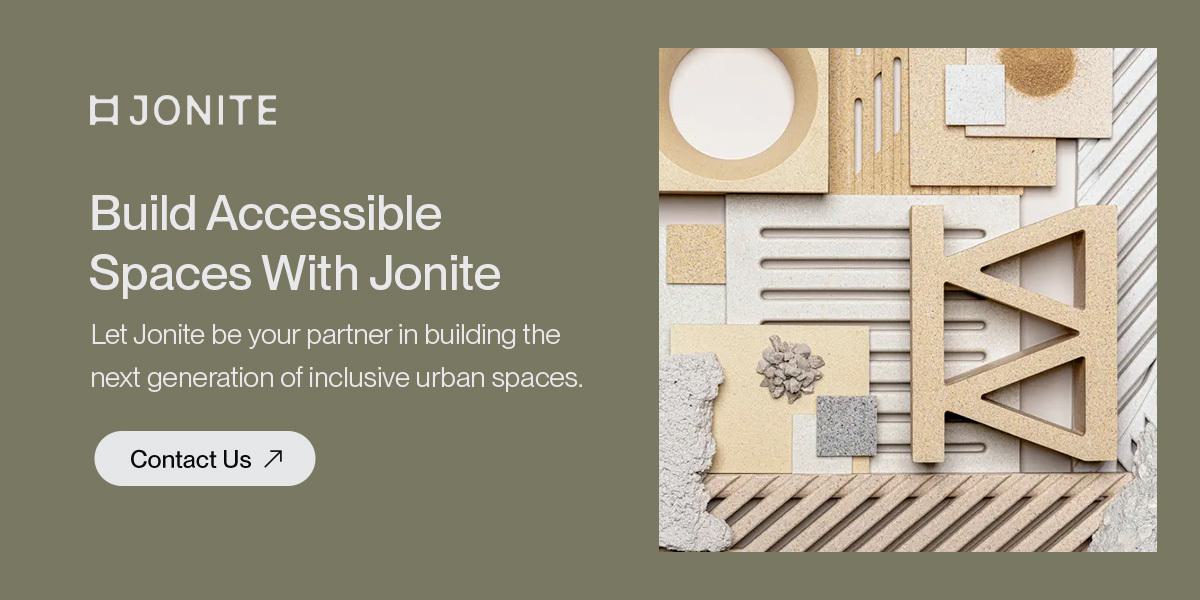Designing urban spaces that are truly inclusive is a mandate for modern cities. As architects and landscape architects, you’re tasked with creating environments that welcome everyone, regardless of ability.
Explore the regulations and principles of accessibility architecture and the practical solutions that make urban areas accessible to all.
Why Is Accessibility Important?
Many public spaces unintentionally create barriers that limit participation and independence for a significant portion of the global population — for example, over 12% are elderly and one in six has a disability. However, when urban environments are thoughtfully planned for people of all abilities, they become places where everyone can move freely, interact and contribute to community life.
Accessible city design is about more than ramps and elevators. It is a philosophy that shapes every aspect of the built environment. It is also an imperative. By applying the following core principles, designers can create spaces that are intuitive, safe and enjoyable for all:
- Equitability: Spaces that are usable by people with diverse abilities, without the need for adaptation or specialized design.
- Flexibility: Design that accommodates a wide range of preferences and abilities.
- Intuitive flow: Wayfinding, signage and spatial organization that is easily understood, regardless of a user’s experience or cognitive ability.
- Multi-sensory design: Tactile paving, audible signals and visual cues to support people with visual, auditory or cognitive disabilities.
- Melded hardscape and landscape: Thoughtful placement of grates, benches and plantings for an accessible journey through public spaces.
What Does It Mean to Be ADA Compliant?
The Americans with Disabilities Act (ADA) sets the legal foundation for accessibility in the United States. For urban designers, understanding the nuances of ADA compliance is crucial for creating urban spaces that enable everyone to fully participate in public life.
ADA standards have a broad scope, applying to residential and commercial buildings, facilities and public areas. Key provisions of ADA compliance for urban areas include:
- Minimum sidewalk widths to accommodate wheelchairs and mobility aids
- Stable pathways free of obstacles
- Slip-resistant surfaces to prevent accidents
- Curb ramps to access sidewalks and center islands
- Tactile warnings and ground markings for navigation
- Accessible public restrooms
- Ramps and railings
These standards are grounded in the real-world experiences of people navigating public spaces. Steep ramps, narrow entranceways and uneven surfaces all present significant barriers, impacting quality of life and mobility. Careful attention to urban design, including the use of boarding ramps, accessible entrances and unobstructed surfaces, can dramatically improve mobility and access to public spaces.
ADA Compliant Grate Openings
One of the most overlooked yet vital aspects of accessible design is the specification of grates and surface openings. These hardscape elements play a vital role in urban environments, but they must be specified with accessibility in mind. These details can make the difference between a safe, navigable space and one that poses hazards for people using mobility aids.
The ADA requires that these features meet specific standards for opening size, placement and surface continuity to ensure safety and usability. ADA-compliant design requires that openings in ground surfaces not exceed 1/2 inch in the direction of travel. This standard prevents wheels, canes and walkers from becoming trapped, reducing the risk of trips and falls.
Aesthetic considerations are important, but compliance is nonnegotiable — products must meet both design and regulatory standards. When chosen carefully, these elements can provide essential functions without compromising the space's accessibility or aesthetic quality.

Advancing Accessibility in Public Spaces With Jonite
What does accessible city design look like in practice? Every detail of a space, from the materials underfoot to the design of street furniture, should empower people of all abilities to move freely and confidently. By combining innovative engineering with refined aesthetics, Jonite helps architects and landscape architects realize their vision for barrier-free environments that are beautiful and functional.
From ADA-compliant trench and tree grates to custom street furniture, Jonite solutions ensure every detail supports safe, unobstructed movement for all in the following ways:
- ADA-compliant grates: Jonite’s ADA-compliant grate openings and tree surrounds are designed to meet regulatory standards while elevating the visual appeal of urban spaces. Jonite tree and trench grates are engineered to meet or exceed ADA requirements. This prevents wheels, canes and walkers from getting trapped, reducing the risk of trips and falls for people using mobility aids.
- Slip-resistant surfaces: Jonite’s reinforced stone grates are engineered for slip resistance and smooth transitions, supporting safety and design continuity in accessible pathways. The matte surface of our trench grates provides excellent slip resistance. We rigorously test our grate covers using the Pendulum and Ramp methods, achieving a class V rating on the Pendulum test and an R10 rating on the Ramp test.
- Seamless transitions: Jonite grates are designed for smooth integration with surrounding surfaces, minimizing level changes and tripping hazards at the interface between hardscape elements and pathways.
- Custom street furniture: We offer benches, seating and other urban furnishings thoughtfully designed for accessibility with appropriate seat heights, armrests and clear space for wheelchair users.
- Aesthetic integration: With a wide palette of colors, textures and patterns, Jonite products blend into any landscape or architectural style, ensuring that accessibility enhancements never compromise design intent.
Jonite Safety and Visual Appeal in Practice
Aura Boca is a contemporary residential development in Florida that blends urban convenience with resort-style amenities. It was envisioned as a modern, accessible community where safety and sophistication are paramount. The development’s outdoor leisure areas, particularly the poolside environment, required materials that could deliver safety, high performance and refined aesthetics.
Pool grates from the Cobble Collection were selected for their contemporary design, anti-slip properties and weather resistance. The engineered stone finish and reinforced aluminum frame provided a durable and elegant solution that integrated with the landscape and architectural vision. Slip resistance was a priority, given the consistently wet deck conditions created by the overflow pool design and the high volume of foot traffic.
Jonite’s grates delivered reliable anti-slip performance and ensured optimal drainage, minimizing splash accumulation and supporting resident safety. The result was enhanced accessibility and visual appeal of Aura Boca’s outdoor spaces. Residents and visitors have benefited from secure, slip-resistant surfaces that allow for confident movement around the pool area, while the sophisticated design of the grates complements the upscale finishes throughout the development.
Build Accessible Spaces With Jonite
Universal design is more than a checklist of accommodations to be added after the fact. Instead, it is a holistic approach that anticipates and embraces human diversity from the outset, so every aspect of the built environment is welcoming, functional and beautiful for all.
At Jonite, we believe inclusive urban design starts with the right materials and a partner who shares your vision for accessibility and beauty. For over 30 years, we’ve helped architects and landscape architects transform public spaces with products that set new standards for both compliance and creativity.
Our reinforced stone ADA-compliant grate openings are engineered to meet ADA requirements for opening size, slip resistance and durability so every surface is safe and accessible for all. With a wide palette of colors, textures and patterns, Jonite grates integrate into any design, elevating function and aesthetics.
Beyond compliance, Jonite grates deliver reliable surface water management and long-lasting performance while maintaining a level, accessible walking surface. Our ongoing commitment to innovation means you never have to compromise on design flexibility or sustainability.
Let Jonite be your partner in building the next generation of inclusive urban spaces. Explore our ADA-compliant solutions or contact our team to find the perfect fit for your project — and discover how we continue to challenge what’s possible in urban design.





